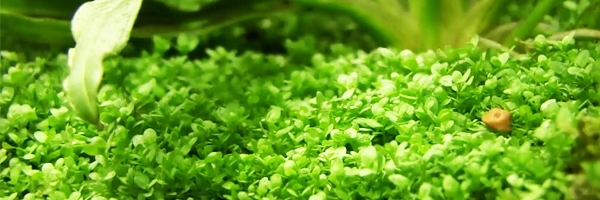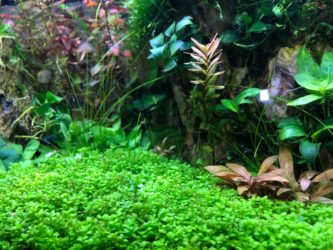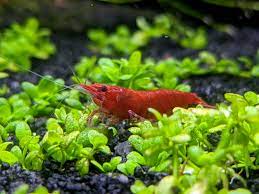Dwarf Baby Tears, also known as DBT or Hemianthus Callitrichoides in aquarium literature, is one of the most popular foreground plants for planted aquariums.
It grows tiny, bright green leaves at an amazing speed, covering the tank floor with a lush emerald carpet.
The DBT naturally occurs in Cuba but has spread through planted tanks worldwide. They are usually sold individually in small pots or, for less patient aquarists that want an instant carpet, they come already grown and rooted in coco fiber mats.
They can also be found rooted on driftwood pieces for aquascaping purposes.

Table of Contents
Dwarf Baby Tears
Most aquarium species like the Dwarf Baby tear plant. Its level of care is medium to difficult. It requires high light for up to 12 hours for development. They have a low growth rate but slowly spread throughout the aquarium.
Dwarf Baby Tears Overview
Dwarf Baby tear plant is the smallest plant with lushing green leaves and crawling stems. This plant can cover the whole tank substrate and provide greenery in the foreground of your aquarium. Goldfish, shrimp, guppies, and beta fish are mostly found in these dwarf baby tears, and they also love to hide themselves in this plant.
Its level of care is medium to difficult. Therefore, it is not perfect for beginners. Let us understand it and its care in the following article. At the end of the article in the FAQs section, we will discuss some commonly asked questions.
Dwarf Baby Tears Appearance
Let us first start with the appearance of dwarf baby tears. Its look will make you fall in love with it. It can spread throughout the aquarium. If grown inside the aquarium, it becomes a soft bed for snails and shrimps to enjoy. The dwarf baby tear has small and soft leaves quite near each other, due to which they provide you denser greenery to the substrate of your tank.
Dwarf Baby Tears Size
Dwarf baby tears are plants that do not attain a good height as they are only used for carpeting in tanks. They can increase up to only 1.2 inches, and wider they can spread up to 4 inches. If carried well, they may spread wider up to 5-6 inches. It is considered to be the smallest among aquatic plants.
Facts About Dwarf Baby Tears

Most loved plant: Even to maintain dwarf baby tears well, it needs a lot of care. Rather than this fact also it’s one of the most favorite foreground plants among aquarium lovers. When it spreads completely all over the substrate, the green contrast attracts you to its beauty. That makes it of the most loved aquatic plant.
High-intensity lighting: Dwarf baby tears require high light. Therefore, they are usually grown with only those plants which require the same level of light, such as Macrandra, Christmas Moss, and Eleocharis montevidensis. You need to keep the lights on for up to 10-12 hours for synthesis and development.
Do not require that much care as you are thinking: Generally, beginners ignore this variety of plants because of its care level. It requires care but not that much as you are thinking. Once you have settled the tank conditions and formed the environment, they have natural habits. Then you don’t have to be worried, decrease the water level after every week up to their rooty levels.
Spreads throughout: dwarf baby tears grow with a low growth rate, but anyhow they slowly cover and spread all over the aquarium. If you want it to grow faster, you need more stems o use cuttings of well-grown plants.
Are Dwarf Baby Tears Right For You?
If you are looking for a small aquarium plant that can carpet your whole substrate area. We would recommend you add dwarf baby tears in your tank. You do not need to worry whether tank species would like it or not, as it is liked and loved by many aquarium species.
Small species such as shrimps and snails play and hide in this plant. They love it too much because it is quite soft and provides them with a better bed. Dwarf baby tear color your substrate with green vibrance. It gives a cool look, and we are sure that you and your species would enjoy it a lot.
What Is Dwarf Baby Tears’ Height?
The baby tear does not have a high height. Its height can only reach up to 10cm (1.2 inches) if it’s well maintained. Just due to its small height, it is used as carpeting the ground of your substrate. However, its height is not small for small species such as shrimps and snails. They can even completely hide themselves under the leaves of dwarf baby tears. If you have any doubt regarding its size, you may check the above-given section “Dwarf Baby Tears Size.”
Can Baby Tears Grow Underwater?
The baby tear can grow well in the lower water level. But the problem occurs when we think of growing them in our tank. They can survive in the full-filled tank, but not longer. Therefore, you need to decrease the water level for some time.
After every week, you need to change the water from the tank, and the floating leaves are to be collected out of the tank. Now our main question is can they live underwater? Yes, they can, but you need to drop the time level to the roots level every week. If you do not perform this, they might die inside the tank.
How To Plant Baby Tears Aquarium?
You do not need any hard course to grow dwarf baby tear plants as they are too easy to grow. You need to take healthy stems of baby tears and plant them like other plants. You need to take care that the roots are deeper because they must be under the substrate.
If the roots are not deeper, the plant could float away. Once your plant is fully grown to spread, you can trim the stems from the plant to plant them everywhere on the substrate. Trim only those items which are healthy and more green.
Can Dwarf Baby Tears Grow On Rocks?
The dwarf baby tear is ideal for the foreground, and people use it as a mat in their tanks. However, you would be shocked after knowing that it can grow on hard surfaces like rock and wood.
You can also use the rock as a substrate, or any other substrate can also be used, but this plant also prefers hard substrate. If you have stones in your tank, a dwarf baby tear will cover your stones also. Growing them on rocks could be time-consuming, but it is healthier for baby tears.
Tank Requirements
The Hemianthus Callitrichoides will thrive in mostly acidic water with a pH range between 5.0-7.5 and a temperature between 70-84 degrees Fahrenheit. Being so small, this plant is ideal even for Nano tanks, provided they are well-lit.
Light as strong as 2 watts per gallon minimum should be available to keep the plant growing close to the ground. Less light will cause it to rise up to the water’s surface, where it naturally lives in the wild.
Planting your Dwarf Baby Tears
Dwarf Baby Tears are usually found rooting on porous rocks or driftwood pieces. They can also be planted in the substrate as a foreground plant, but the effect is much stronger and natural when attached to other tank objects.
You can tie small sections of Hemianthus to a rock or wooden piece of your choice and leave it to develop its roots around the object. Most aquarists prefer using cotton thread instead of rubber bands or fishing lines, as it is hardly noticeable and it dissolves over time, leaving only the roots attached.
Another way of keeping them from floating around would be to cover the Dwarf Baby Tears’ roots with moss that will add some weight to the plant.
These mosses will provide extra nutrients, as well as a good hiding ground for newly hatched fry.
For planting in the substrate, you can plant a whole pot in one place and wait for it to spread, or you can separate small stems and plant them about one inch apart for faster coverage.
This is a time-consuming process, though, so allow some aquascaping hours. Plant the stems using a No products found. and make sure the roots are well inserted in the soil.
Care
Dwarf Baby Tears need a fine-grained substrate rich in nutrients and minerals, especially iron. The plant is sensitive to iron deficiency and will display yellowish leaves if there is not enough iron in the tank.
They will do best with CO2 supplementation and constant fertilization to help accelerate the growth rate.
Always prune this plant, as while growing, new stems will get on top of old ones and suffocate them; DBT literally kills itself if left unattended.
Trim the stems with a very sharp pair of scissors or a razor blade to help keep them in place while trimming.
Reproduction
The Hemianthus has pretty slow growth and development rate, but will still spread across the substrate after settling in your tank. Roots will branch off and develop an intricate network, resulting in a carpet-like appearance, but only if you remember to constantly trim the plant to keep it low.
Another popular method of propagating the Dwarf Baby Tears is to cut off smaller sections of larger plants and replant them in the substrate.
This way, they will cover up the tank floor faster, as propagation is made from many points.
Dwarf Baby Tears Compatibility and Tank Mates

The Dwarf Baby Tears can be planted alongside other short foreground plants in contrasting colors. The dense carpet will allow spawning fish to lay their eggs and the young fry to hide from harassing adults.
There is no worry if plant-nipping fish graze on the DBT, as they will quickly recover and grow again, especially if it has already covered a considerable surface.
Try not to add ravaging fish, such as Oscars or Jack Dempseys, to a tank planted with DBT, as they will try to uproot weaker stems when “rescaping” the tank.
Goldfish are not a good idea because of their different environmental requirements and because they will stubbornly try to eat as much of the plant as possible.
Be creative and use your imagination and try some aquascaping tricks with this small versatile plant. You can use it in many tanks, from the smallest to the largest, in a variety of ways.
Conclusion
In the end, we would only suggest that if you have experience in an aquarium setting, you can go with this plant and can use it as carpeting, but if you are a beginner, you should first get some experience.
No related posts.

3 thoughts on “Dwarf Baby Tears Guide: Appearance, Size, Height, Care”
Thank You
Detailed and informative article
Thanks for this post! I purchased a mat of HC pre-rooted in coconut fibre for my CO-injected tank. It looked great for about 2-3 weeks, then I noticed that it was loosing leaves from the mat. Currently I have a whole mess of HC floating at the surface (it’s clearly reproducing), but the mat is nearly empty 🙁
So any ideas what I might have done wrong? I use liquid fertiliser, although not as frequently as I should. I suspect that this isn’t the issue as the HC is growing – just on the *surface* of the water.
Is there any reasonable way to re-plant the floating stuff?
Tank details:
36gal bowfront
CO injection
2x39W 6500K T5 lighting (~2.2 W/gal)
I have a very healthy carpet and a large mass of DBT floating on the top for cover.
I started the DBT from seeds. How do I get the current plants in my tank to start producing seeds?